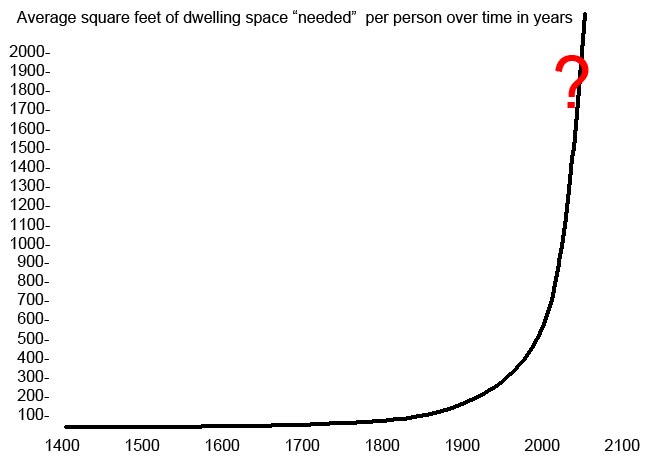1Sphere 1People Homestead
A developing intentional community in SE Arizona
![]()
How much space do we need—really?
How much living space does a person need? The range of answers, reflecting perceived more than actual necessity, is remarkable. Federal guidelines for fallout shelters specify a minimum of 10 sq. ft. (1 m2) per person. However, one designer of fallout shelters for the wealthy argues that nothing less than 1400 sq. ft. (130 m2) should be considered to meet the needs of one couple for a few weeks. Apparently there are people who can't imagine surviving for even a short time in any space less accomodating.
Then there is the story, told by an American traveling in India, of a large extended family living in an abandoned section of concrete pipe. What the American found incomprehensible was the apparent happiness of the family. When questioned they explained that they were extremely fortunate to have such a fine and substantial abode as all of their poorer neighbors had to make due with much less.
A clue as to what is actually needed comes from pre-Columbian Native American dwellings (wikiups, tipis, hogans, pit-houses, longhouses). Each dwelling was inhabited by a family or even by multiple families, and the space per person ranged from about 20 sq. ft. (1.8 m2) per person for modest abodes to as much as 60 sq. ft. (5.6 m2) per person in some of the luxuriant multifamily longhouses in the settled agricultural villages (whose inhabitants could have built even more or larger houses but doing so was just not worth the time and effort). But for those who live outdoors, for whom nature is their home, dwellings are needed for little more than a place to sleep out of the weather.
Modern Americans, sequestered in their homes, cut off from nature, need, or have been convinced they need, on average 970 sq. feet per person (average single-family “McMansion” in 2007 was 2521 sq. ft. (234 m2) occupied by 2.6 persons). In 1954 Levittown offered, for those looking to move up in the world, large 1000 sq. ft. (93 m2) homes designed for up to 8 occupants (125 sq. ft. [11.6m2] per person). In 1845 Thoreau thought himself well served by a 150 sq. ft. (14 m2) cabin he bought from its former occupants—an immigrant family. Historically, in urban areas, people lived 2-3 persons per room (or about 0.4 rooms/person) and in much of the world people still do. Today, in America, there is on average 2.2 rooms/person (5.8 rooms/house, not counting bathrooms and storage rooms, divided by 2.6 persons/house).
So, how much room do you need—really? A reasonable guess, based on past perceptions and, more importantly, the past couple of hundred thousand years of human experience, would err on the high side and put the figure at somewhere between 60 and 180 sq. ft. per (5.6-16.7 m2) person. Throughout most of human history, 60 sq. ft. per person would have been considered extravagant, while even the least adaptive should be able to make due with three times as much. As for rooms per person, how about something between 0.4 and 2.2? How about one room per person average?

At the current rate of growth in perceived space needs, the average American, in 2040, will “need” over 2000 sq. ft. (185 m2) and half of all Americans, by definition, will have even more. Should, or more pointedly, can this trend continue? How much consumption is enough? How much of earth's resources can be appropriated per person before there's nothing left—before we reenact Easter Island on a global scale? Perhaps instead of relentlessly pursuing the upper limits of More, what we need, really need, is to start exploring the lower limits of Enough.
Towards this end we've proposed the POD House Design Challenge: Click here to see what a POD house might look like.
Contact Us
![]()
- Visit our Zazzle store:
Support this site: Visit our Zazzle store featuring ultra hi-res images of artworks, Hubble/ESA/NASA space images, Mandelbrot fractals, maps and more. Images up to 525 megapixels allow for fine printing at the largest sizes. Consider giving a fine print as a gift that could hang on someone's wall for a hundred years or more.
1Sphere 1People Homestead Site Map
- •Home Page
- •Mission Statement
- •Who are we? Personal profiles
- •Where are we in SE Arizona?
- •Units Available: Vacancy?
- Description of Unit 1
- Description of Unit 2
- Description of Unit 3
- Description of Unit 4
- Description of Unit 5
- Description of Small Mobile Home
- Description of RV Space 1
- Description of RV Space 2
- •Utilities
- •Community Areas
- •Compatibility Issues: Will you fit in?
- •On Human Needs: What do you need?
- •One Homestead: Experimental Farm
- •How much space does a person need?
- •Nearby Hiking Excursions
- •Alternative Dwellings: POD Houses
- •Alternative Dwellings: Thoreau Cabin
- •A History of the St. David Area
- •1Sphere 1People Homestead FAQ
- •1Sphere1People Annex
- •History of 1Sphere 1People Homestead
- •Geological Map of Area
1Sphere 1People Homestead Projects
External Links
- Fellowship for Intentional Community
- Center For Inquiry
Promoting Community Living and Cooperative Lifestyles Across North America.
Your portal for skeptical and free inquiry.